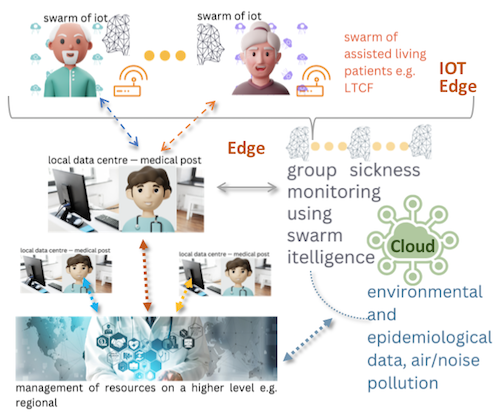USE CASE: Revolutionizing health monitoring with IoT swarms
Imagine a nursing home where every resident has own personal intelligent health assistant that receives health data from cutting-edge wearable devices tracking health biomarkers, vital signs, physical activity 24/7. Interconnected to each other and facility system, these health assistants create a swarm providing comprehensive health assessment of many patients in real-time.
This project demonstrates that advanced health monitoring of individual and collective health status can help identify trends and problems affecting the entire community (such as epidemics). With edge and swarm intelligence, real-time data saves lives.
Let’s have a look at the diverse sensors available for this experiment. An individual wears non-invasive and invasive wireless devices that constantly tracks the pulse, blood pressure, body temperature, respiration (vital signs), as well as physical activity, falls, and location. Optional measurement devices that could be necessary are weight scales, glucose, etc. In addition, other sensors throughout the facility measure actual living conditions such as air quality, temperature, humidity, CO2, and air particles.
These devices come together as IoT swarms, and the data they gather supply each individual virtual assistant and its corresponding facility swarm with comprehensive evidence in the form of measurement data. This data represents the health status of both individuals and all residents as a whole, accessible at any time.
This collective health status can help identify change trends or problems affecting a group, enabling the relevant care staff to take proactive timely measures to improve the overall well-being of the entire community. In this way, healthcare organizations can react quickly to any deviations from normal state of health, and, if necessary, take mitigating actions (e.g., adapting living conditions, setting up individual care plans for residents, change of treatment protocols). Such a holistic approach ensures the best possible care for residents, contributing to their overall well-being.

Figure 1: Representation of swarm on the different levels
One of SmartEdge’s goals is to develop a solution capable of processing signals from two levels of swarms (see Figure 1 above): a group of interconnected IoT devices (Level1 Swarm of IoT), linked to virtual personal health assistants assigned to each individual and a large group of people represented by their virtual swarms (Level2 Swarm of Personal Virtual Health Assistants).
Edge Intelligence brings computing closer to data sources and, by adding machine learning and artificial intelligence capabilities at the edge of the network, makes this solution ideal for real-time healthcare applications. In the project, each wearable and sensor is considered an IoT node, and together they form an “IoT swarm”.
Each virtual personal health assistant operating in an edge is connected to several IoT devices and is also considered a swarm node representing the individual concerned. This humane approach enables us to obtain a global view of the health status of the entire community represented by these nodes, taking the efficiency of health monitoring to a new level.
Swarm intelligence allows the system to learn from multiple data, identify patterns and make predictions. For example, it can detect the early signs of an infectious disease in a patient based on subtle changes in vital signs, such as an increase in body temperature or a change in heart rate, while considering similar changes in the swarm group. It enables the rapid identification of trends affecting the health of the group or community, for example a sudden increase in similar symptoms among several residents, which may indicate the starting point of an epidemic. By recognizing these patterns at an early stage and having the information available in time, the staff concerned can take preventive measures, such as isolating patients or conducting additional prevention and mitigation measures to control the spread of the disease.
SmartEdge includes an edge intelligence part and a swarming concept, enabling an application dedicated to healthcare to be run on the top. Such synergy will enable healthcare professionals to access real-time health status, receive notifications and proactively manage individual and collective health. This capability allows all stakeholders to react to health problems before they escalate, potentially saving lives and resources. It also enables health authorities to act quickly to manage and mitigate the consequences of disease outbreaks. This use case for the project SMARTEDGE in the healthcare sector shows that it is not just about technology, but also about improving people’s lives.
Lying at the intersection of technology and healthcare, we believe that this use case has the potential to transform public health management. We look forward to sharing our successes and results as we continue to develop this innovative solution.
Author: Elena Petrova, MSc, CEO IMC-Industrial Management Consulting Slovakia s.r.o.
